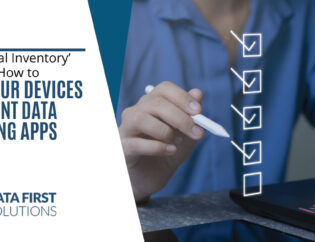
With the right customized IT solutions, organizing your data doesn’t have to be hard. It will actually transform the way you work by enabling you to make better decisions, operate efficiently, and retain customers. Reliable data isn’t a luxury, it’s a necessity.
Let’s explore data governance, and how it can help small businesses regain control.
What Is Data Governance?
Data governance is all about managing and organizing your data so it stays accurate, secure, consistent, and used the right way across your business. It sets guidelines for how data is handled, like who can access it, how it’s stored, shared, and kept up to date.
Three Must-Haves for Robust Data Governance
It’s simple to get started, no complicated steps required. Just follow three easy steps:
1. Clear And Actionable Policies
Data governance policies shouldn’t be written and forgotten. Keep the rules simple, practical, and part of everyday workflows. Ditch the tech jargon and focus on what truly helps your team:
- Set naming conventions everyone uses.
- Define how customer records should be entered.
- Make sure your team knows how to handle sensitive data.
2. Reliable Data Quality Management
Even the best data tool is useless if the information inside it is outdated or wrong. Good data governance starts with making data quality a priority from the beginning.
Some tools and habits that help:
- Validation tools to catch missing or mismatched info
- Cleansing processes to remove duplicate or old entries
- Dashboards that track and flag problems in real time
These don’t have to be fancy. Many small businesses make big improvements just by consistently using the tools they already have, guided by a reliable IT partner who can point them in the right direction.
3. People Who Know Their Role
No system works without accountability. Make sure everyone knows their role and who handles what.
- Data Owners: They set the standards and make top-level decisions.
- Data Stewards: They handle day-to-day cleanup and maintenance.
- Governance Leads: They connect teams, keep things on track, and make sure everyone knows their role, so problems get fixed quickly with fewer mistakes.
Why Small Businesses Can’t Afford to Ignore Data Governance
For small and growing businesses, data governance might seem like something only large companies need to worry about. But the truth is, bad data can cost you more than you realize.
Here’s what good governance delivers:
- Smarter, data-driven decisions
- Faster reporting with fewer manual checks
- Improved operations with fewer delays and duplicated efforts
- Data accuracy and consistency across systems
- You can trust these analytics to help you grow.
In short, it’s about making sure your data is trustworthy, well-managed, and working for your business, not against it.
Signs Your Governance Isn’t Working Yet
Not sure if you need to overhaul your current data governance practices? Look for these red flags:
- Different teams are using different versions of the same data
- Reports that take forever to compile and still contain errors
- Duplicated customer entries with conflicting details
- Mistakes that affect various departments.
If any of these situations sound familiar, it’s a clear sign your data governance strategy could use some attention.
How to Get Started
Ready to make a change? Begin with small, simple steps that create lasting impact:
Step 1: Know What You’re Aiming For
Think about what you want from your data, where things aren’t working, and which areas need help. Then set clear, simple goals based on that.
Step 2: Give Everyone a Clear Role
Assign clear ownership for each major data category by pairing tech experts with business leaders who understand the day-to-day operations.
Step 3: Keep the Rules Simple
Keep the rules simple and focus on things your team can follow. Rules should be realistic, like using consistent names, clear formats, and safe data entry.
Step 4: Pick Tools That Actually Help
The best tools are the ones your team will actually use. Choose platforms that:
- Fit your existing systems
- Are easy to learn
- Can scale as your business grows
Work with a smart IT partner who can help you benefit from the right tools while reducing unnecessary costs that come with purchasing tools.
Step 5: Start with One Thing
Choose one area to start with and build from there. Show your team how trust in data helps drive progress and long-term success.
Step 6: Grow at Your Own Pace
As your system grows, expand it across teams, check in often, and adjust as your business changes to stay efficient and ready for new opportunities.
Common Pitfalls to Watch Out For
Avoid making irreversible changes right away. Instead, prioritize the most important tasks first. Secure support from leadership early to ensure you have the time and resources needed. Keep the employees who manage the processes involved, and focus on clear communication and proper training. Make sure your tools fit smoothly into existing systems, and always align your efforts with real business goals like better workflows or improved customer experiences.
Let Data First Solutions Help You Take Control of Your Data
Data management doesn’t have to be overwhelming. With Data First Solutions, you get a trusted IT partner who understands your business and offers customized support every step of the way. From cleaning up messy systems to building a strong data strategy, we help you make smart decisions with confidence. It’s not about being perfect, it’s about making progress. Start small, build smart, and let your data work for you.
Ready to take the next step? Contact Data First Solutions today.









